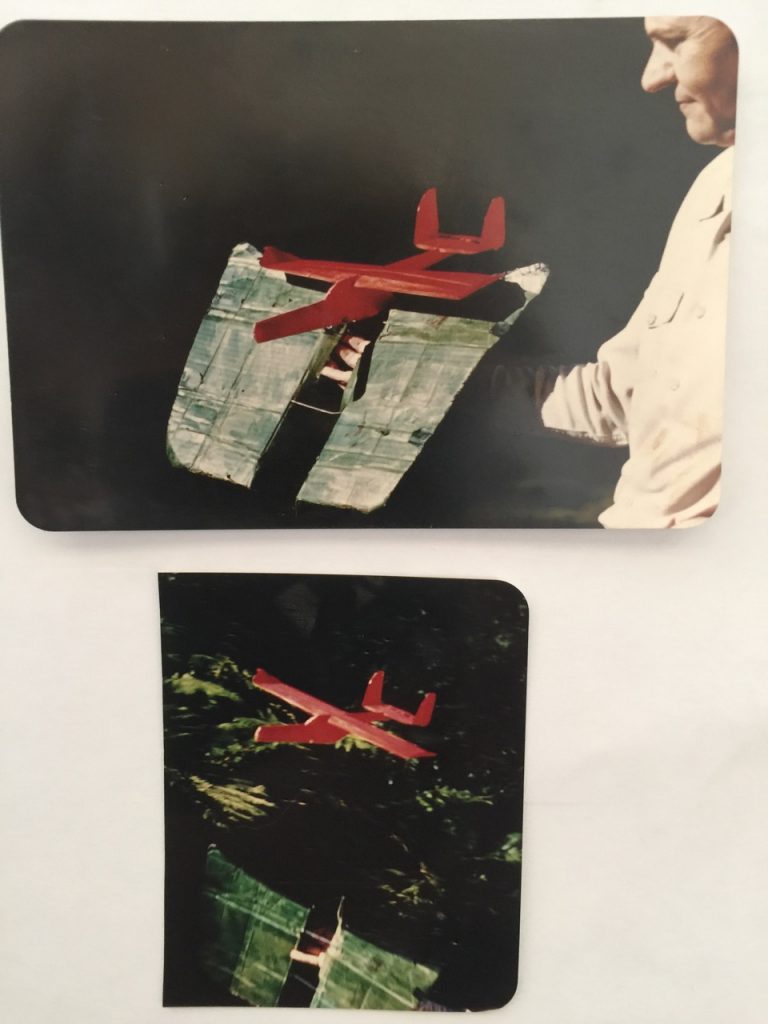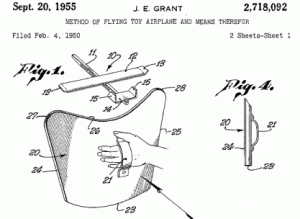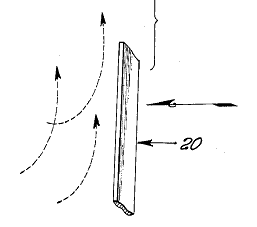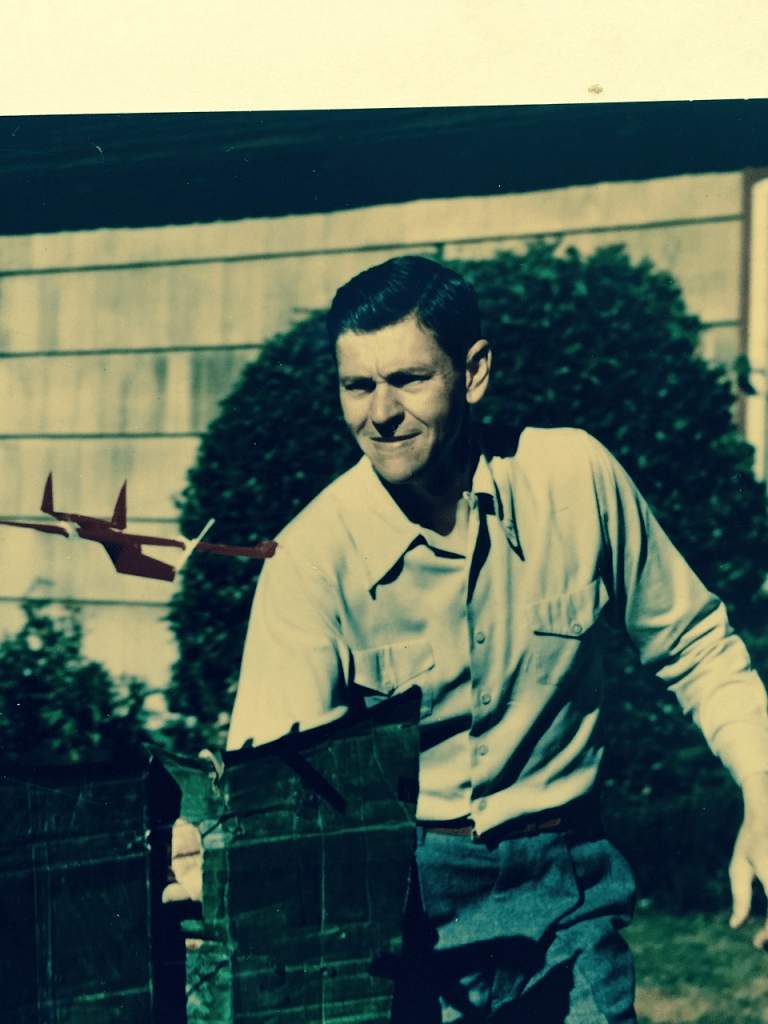
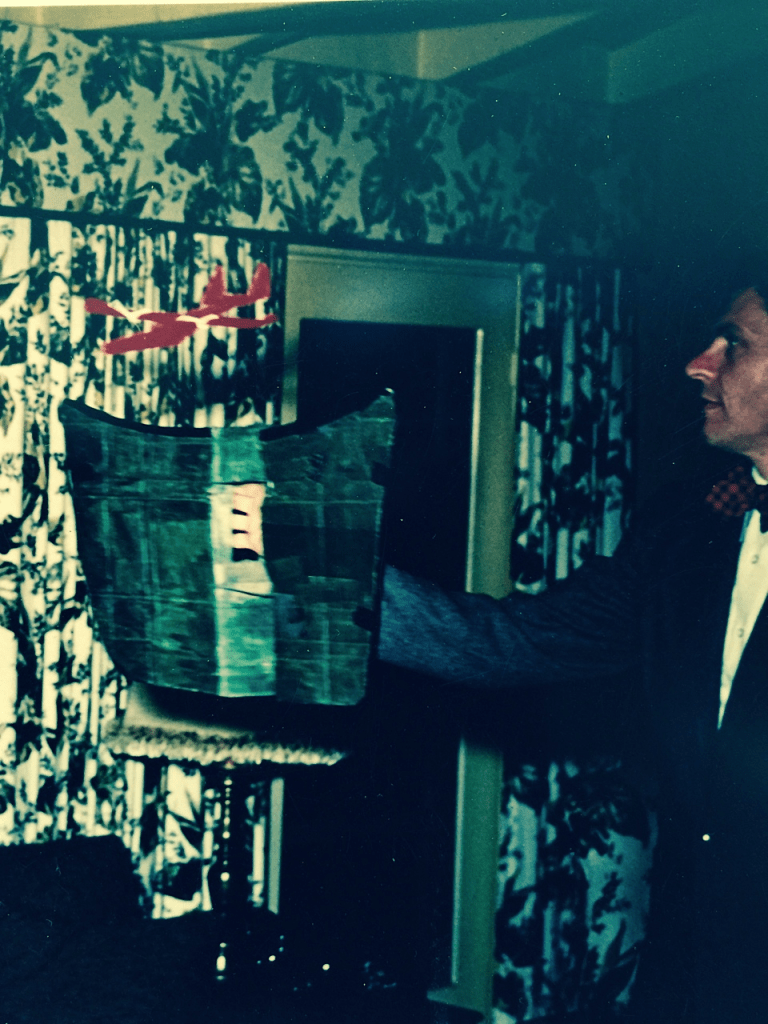
Above are pictures from the 1950s of Joseph Grant flying his invention.
It looks like he invented spinning props for the gliders, too – truly a man ahead of his time.
Here are some more photographs that Whitney Grant found and scanned. She said, "Here are the two photos that I found recently. They are similar to the others that I shared with you but fun to see different versions. Ironically, these were taken December 11, 1950 ..... 67 years ago - almost to the day!"
It shows clearly a prototype launcher that puts everything at the right place and the correct angle. I am speculating that the open part in the middle might create more efficient turning--I'll experiment with it. The pictures also show his vertical tips. They also strengthen turning ability.
I am fascinated by the history of science. It's interesting to see how scientific ideas originate and develop, so naturally I wanted to know the creation story of walkalong gliding. I learned that the concept was not invented once, but twice.
On a separate page and video interview, Dr. Tyler MacCready recounts how he and his brothers invented and developed the basic concept of walkalong gliding in the late1970s while his father and friends were inventing human-powered flight. But when the family filed for a patent, the patent search revealed that one Joseph E. Grant had filed a patent for a walkalong glider almost 3 decades earlier. The following is an attempt to understand who Joseph Grant was, how he came to invent walkalong flight and why it was not commercially viable at the time.
Finding Joseph Grant
That Joseph Grant conceived the concept of walkalong flight is remarkable achievement. A lot of brilliant people in aviation history—kite makers starting in China, Leonardo da Vinci, Tito Livio Burattini, Jean-Marie Le Bris, Otto Lilienthal, the Wright brothers and countless others—grappled with the components of flight, yet there is no record of the walkaong concept until Grant's patent. It is logical that the MacCreadys would re-invent walkalong gliders in the ferment of inventing human-powered flight. Also, they were all experts at hang gliding, which uses "ridge-lift": wind that hits a mountain and is forced to go up, which keeps the hang glider up. With walkalong gliding, you "move the mountain" so to speak—the deflecting board—and direct apparent or relative wind up. It's not hard to see that hang gliders and walkalong gliders are similar in that way. But inventing the later from the former is still a giant step.
I looked up the patent and started looking for Joseph Grant. And looked. For years I tried genealogy sites. Finally, my friend Erik Herman took a shot and made the big breakthrough right away. Erik and I were working on a project at the New York City branch campus of Cornell University. Erik left a message at a telephone number that might be associated with Joseph Grant. That evening we were at a pub soaking in some live Celtic music when we got a return call, and after years of searching for more information about this mysterious inventor of walkalong gliding, I was suddenly talking to Whitney, his daughter! We had a wonderful conversation. Whitney remembered her father flying the glider in the yard. However, she was unaware of the renewed interest in walkalong flight. Subsequently, I also had terrific conversations with Joseph Grant's other daughter Stephanie and his son Greg. At last I could learn more about the inventor of walkalong flight.
Diverse Interests
Joseph Grant was born in 1912 in Los Angeles, a few months after the Titanic sank. He passed away in 1988. His wife Hortense was born 1917 and passed away in 2012. In all the conversations with his children, two characteristics emerged immediately. First, he was a wonderful father: devoted, encouraging, working on projects and traveling with his kids. Second, his interests were spectacularly diverse. I hardly know where to begin or how to contain them all in a cohesive essay.
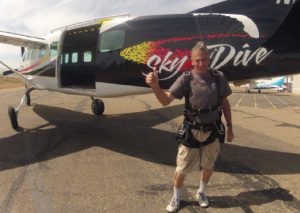
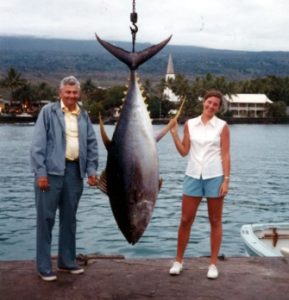
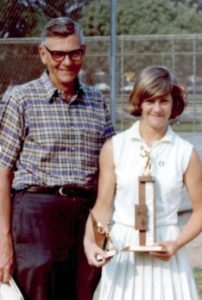
So, they remembered doing everything with him from fly fishing to finding fossils; from Heathkit electronics projects to history—particularly Greek and Roman. He had an ancient coin collection.He got his daughters started playing tennis and took them all around the country as they played competitively. Whitney earned 6 national tennis titles and Stephanie played at Wimbledon.
Son Greg Grant, a history and genealogy buff, might write about the family ancestors. But the drift I got from conversations was that generations of the family worked hard, saved, made wise investments, became prosperous, took some hits but kept going even in adversity. The generations also recognized the value of education. Joseph was one of the early graduates of UCLA. But he was clear that that did not just value formal education; he was a lifelong learner.
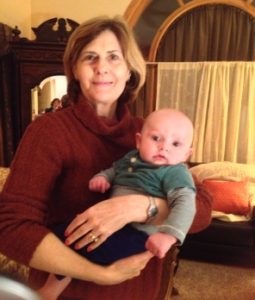
A Sailor
By 1939 Joseph E. Grant was filing for patents. He was also an accomplished sailor and navigator from an early age. When World War II broke out he enlisted as an officer. There were no boats available at first, so for a couple of years he sailed his own boat off the coast of California, spotting for submarines. When a U-boat chaser boat became available he was given command, based near the Panama Canal and protecting merchant ships in the Caribbean. Later in life he used his skills as the navigator for the big Transpac race between California and Hawaii in his brother's sail boat. During the 1955 race he fell overboard, but in 1959 his team won the Transpac. He was one of the first to experiment with home computers (TRS) and create software relating to longitude and latitude. Beyond the practical use of stars for navigation, he loved astronomy.
A Business Man
Joseph Grant was not successful in every business venture, but enough of them worked out that the family was well to do, living in Beverly Hills. There was a hotel that he owned, but a resident was smoking in bed and started a fire. He bred orchids, racing pigeons and tropical fish. He spent his last years establishing a farm in Santa Ynez for raising and training racing horses, working side by side with his daughter Whitney, who is still continuing that today. The earlier orchid farm was not profitable, but the land he bought for it—in Malibu—appreciated remarkably. He was astute at real estate, which supported his family and his many interests. Only after his death did his children learn about the extent of his philanthropy, including people whose education he paid for and support of Native American causes.
Although he got a patent for a walkalong glider, he was not able to market the idea. He did meet with representatives from the Milton Bradley Company but they did not take it up. Joseph Grant was ahead of his time. If he had access to the modern materials of today, perhaps he would have created a commercially viable product.
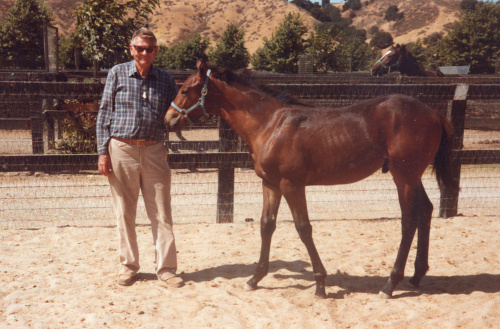

Hortense Grant
Joseph Grant's wife Hortense was as accomplished and interesting as he was. During WWII opportunities opened up for women. She learned to pilot airplanes and had a close call when the engine in her plane stopped. She glided it down to a safe landing. She actually helped design airplanes as well, such as the C-47, for the Douglas Aircraft Company. She was a liaison between the various engineering and design teams. She traveled to England on the Queen Mary Ship just before the bombing of London. She volunteered with the Red Cross there to help in medical facilities and at a gathering saw Winston Churchill. At the war's end she drove a convoy truck into Germany.
Reason for the Invention
Some of Joseph E. Grant's earliest patents relate to filmstrips and he maintained his interest in photography and home movies. There is a tantalizing possibility that there might be a historic home movie of the first walkalong glider being flown by its inventor.
Sailing is the closest I have been able to get to finding a cause and effect that led to inventing walklong gliding. Obviously he thought about how air interacts with surfaces. And son Greg Grant mentioned that in the Transpac race they did not head directly for Hawaii, but instead diverted their route a little so they could sail downwind with spinnaker sails and surf down the swells. Air-surfing is another name for walkalong gliding and it's apt. You actually do surf on the leading edge of an invisible swell of air. It's a long way from surfing on water to surfing on air, but it's the closest I can come to a direct logical reason for his invention.
In the end, the invention of walkalong gliding remains a mystery. I went searching for Joseph Grant's "ah ha" moment. I had delightful conversations with his son and daughters and serendipitously discovered a Renaissance man who was interested in and tinkered with EVERYTHING! Joseph E. Grant embodies the Pasteur quote that, "Chance favors a prepared mind". And ultimately that is a more useful, satisfying and still wonderfully mysterious answer.

